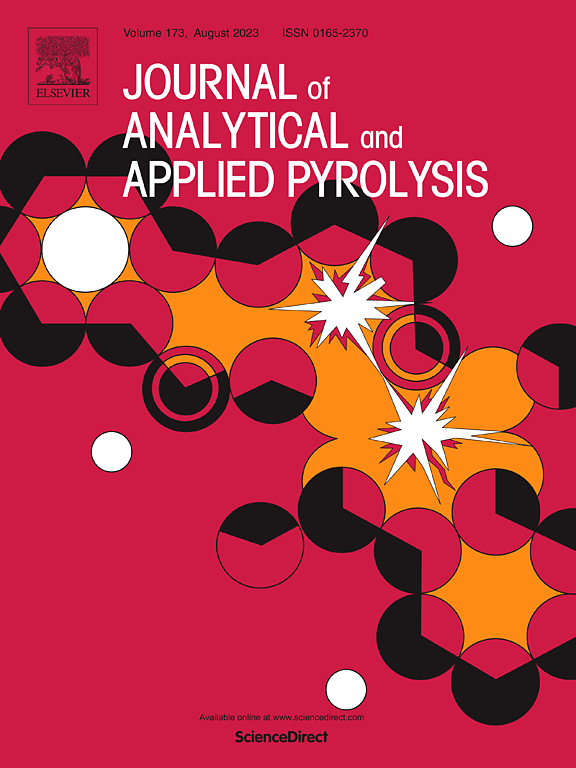ReaxFF MD模拟生物质加压热解过程中组分相互作用的研究:自由基驱动的协同脱氧和聚合反应
IF 5.8
2区 化学
Q1 CHEMISTRY, ANALYTICAL
引用次数: 0
摘要
加压热解可以实现生物质的深度脱氧和升级,而不同生物质的产物性质和反应途径差异很大,主要是由于组分的变化和相互作用。本研究采用反应力场分子动力学(ReaxFF MD)在微观水平上阐明生物质三组分共热解机理。初步研究了温度和压力对单组分热解的影响。结果表明,压力对纤维素和半纤维素的热解有显著影响,尤其是对纤维素,在1400 ~ 1800 K时增加了其炭产率。加压下的H2O和CO2产率明显高于常压。通过比较计算值和模拟值,分析了常压和加压条件下各组分相互作用对产品特性的影响。模拟结果表明,压力增强了组分之间的相互作用,特别是在1700 K以上的温度下纤维素和木质素(C-L)之间的相互作用,最大偏差为13.97 %。在1800 ~ 2300 K时,C2H2O2和C3H4O3的实际产率明显高于计算值,特别是在压力下。C-L共压热解导致更多的-CO和-COOH基团作为醛和羧酸小分子挥发物被去除。纤维素-半纤维素(C-H)相互作用主要发生在挥发物在高温高压下的二次反应中。这些结果与我们现有的实验数据一致。最后,通过跟踪C、H和O元素的动态迁移,揭示了自由基在协同反应中的关键“引发剂”作用。该研究为优化压力条件和组分调节生产高质量生物炭提供了理论支持。本文章由计算机程序翻译,如有差异,请以英文原文为准。
Investigation of components interaction during pressurized pyrolysis of biomass via ReaxFF MD simulation: Free radicals driven synergistic deoxygenation and polymerization reactions
A deeper deoxygenation and upgrading of biomass could be realized through pressurized pyrolysis, whereas the product properties and reaction pathways from different biomass vary significantly, primarily due to components variations and interactions. This study employed reactive force field molecular dynamics (ReaxFF MD) to elucidate co-pyrolysis mechanisms of biomass three components at microcosmic level. The effects of temperatures and pressure on individual component pyrolysis were initially investigated. Results indicated that pressure significantly impacted the pyrolysis of cellulose and hemicellulose, particularly on cellulose, increasing its char yields at 1400–1800 K. The H2O and CO2 yields under pressure were markedly higher than atmospheric pressure. Moreover, by comparing calculated and simulated values, the influence of component interactions on product characteristics under atmospheric and pressurized conditions was analyzed. Simulation results showed that pressure enhanced component interactions, particularly between cellulose and lignin (C-L) at temperatures above 1700 K, with a maximum deviation of 13.97 % in char yields. The actual C2H2O2 and C3H4O3 yields were notably higher than calculated at 1800–2300 K, especially under pressure. C-L co-pressurized pyrolysis resulted in more -C![]() O and -COOH groups removal as aldehyde and carboxylic acid small molecule volatiles. In contrast, cellulose-hemicellulose (C-H) interaction mainly occurred during volatiles secondary reaction at elevated temperature and pressure. These results are consistent with our existing experimental data. Ultimately, by tracking C, H, and O elements dynamic migration, a crucial “initiator” role of radicals in synergistic reactions was revealed. The work provides theoretical support for producing high-quality biochar via optimizing pressure conditions and components regulation.
O and -COOH groups removal as aldehyde and carboxylic acid small molecule volatiles. In contrast, cellulose-hemicellulose (C-H) interaction mainly occurred during volatiles secondary reaction at elevated temperature and pressure. These results are consistent with our existing experimental data. Ultimately, by tracking C, H, and O elements dynamic migration, a crucial “initiator” role of radicals in synergistic reactions was revealed. The work provides theoretical support for producing high-quality biochar via optimizing pressure conditions and components regulation.
求助全文
通过发布文献求助,成功后即可免费获取论文全文。
去求助
来源期刊
CiteScore
9.10
自引率
11.70%
发文量
340
审稿时长
44 days
期刊介绍:
The Journal of Analytical and Applied Pyrolysis (JAAP) is devoted to the publication of papers dealing with innovative applications of pyrolysis processes, the characterization of products related to pyrolysis reactions, and investigations of reaction mechanism. To be considered by JAAP, a manuscript should present significant progress in these topics. The novelty must be satisfactorily argued in the cover letter. A manuscript with a cover letter to the editor not addressing the novelty is likely to be rejected without review.

 求助内容:
求助内容: 应助结果提醒方式:
应助结果提醒方式:


